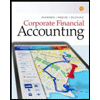
Concept explainers
1.
Cash dividends: The amount of cash provided by a corporation out of its distributable profits to its shareholders as a return for the amount invested by them is referred as cash dividends.
Common stock: These are the ordinary shares that a corporation issues to the investors in order to raise funds. In return, the investors receive a share of profit from the profits earned by the corporation. The dividend payments are not guaranteed and are paid after the payment made to the preferred stockholders.
Preferred stock: The stock that provides a fixed amount of return (dividend) to its stockholder before paying dividends to common stockholders is referred as preferred stock.
A preferred stock may be cumulative and non-cumulative. A cumulative preferred stock implies that a preferred stockholder is entitled to receive dividends for the current year plus any unpaid dividends of the previous years, before the dividends paid to the common stockholders.
Dividend per share:
Dividend per share represents the amount of dividend paid to each shareholders of the business.
To determine: The total dividends and the amount of dividends declared per share for preferred and common stock for each of the six years.
2.
The average annual dividend per share for each class of stock for the six-year period.
3.
The average annual percentage return on initial stockholders’ investment, based on the average annual dividend per share for (A) preferred stock and (B) common stock.
Trending nowThis is a popular solution!

Chapter 13 Solutions
Accounting
- Calculate fixed costs per month on these general accounting questionarrow_forwardHello teacher please provide correct answer of this general accounting questionarrow_forwardMetro Corp. acquires a patent from Maxwell Co. in exchange for 3,000 shares of Metro Corp.'s $5 par value common stock and $85,000 cash. When the patent was initially issued to Maxwell Co., Metro Corp.'s stock was selling at $8 per share. However, when Metro Corp. acquired the patent, its stock was selling for $10 per share. At what amount should Metro Corp. record the patent?arrow_forward
- Provide correct option general accounting questionarrow_forwardFor this year, Jackson Enterprises has $25,000 net earnings on the income statement and $10,000 net cash inflow from operating activities, $18,000 net cash outflow from investing activities, and $22,000 cash inflow from financing activities on the statement of cash flows. What is the accruals total reported for this period?arrow_forwardFind out net incomearrow_forward
- What is the division's margin of this financial accounting question?arrow_forwardWaht is the correct option? General accounting questionarrow_forwardSilverline Enterprises has Total Assets of $9,750, Contributed Capital of $5,200, and Retained Earnings of $850. What is the total amount of liabilities on the balance sheet? a. $4,600 b. $3,700 c. $4,750 d. $9,100 e. None of the abovearrow_forward
- Principles of Accounting Volume 1AccountingISBN:9781947172685Author:OpenStaxPublisher:OpenStax College
 College Accounting, Chapters 1-27AccountingISBN:9781337794756Author:HEINTZ, James A.Publisher:Cengage Learning,
College Accounting, Chapters 1-27AccountingISBN:9781337794756Author:HEINTZ, James A.Publisher:Cengage Learning, Corporate Financial AccountingAccountingISBN:9781305653535Author:Carl Warren, James M. Reeve, Jonathan DuchacPublisher:Cengage Learning
Corporate Financial AccountingAccountingISBN:9781305653535Author:Carl Warren, James M. Reeve, Jonathan DuchacPublisher:Cengage Learning  Managerial Accounting: The Cornerstone of Busines...AccountingISBN:9781337115773Author:Maryanne M. Mowen, Don R. Hansen, Dan L. HeitgerPublisher:Cengage Learning
Managerial Accounting: The Cornerstone of Busines...AccountingISBN:9781337115773Author:Maryanne M. Mowen, Don R. Hansen, Dan L. HeitgerPublisher:Cengage Learning Intermediate Accounting: Reporting And AnalysisAccountingISBN:9781337788281Author:James M. Wahlen, Jefferson P. Jones, Donald PagachPublisher:Cengage Learning
Intermediate Accounting: Reporting And AnalysisAccountingISBN:9781337788281Author:James M. Wahlen, Jefferson P. Jones, Donald PagachPublisher:Cengage Learning





